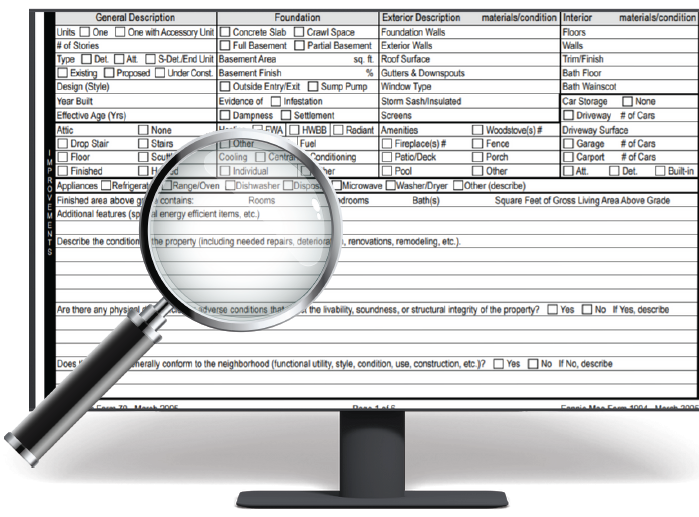


The GSE’s goal is to create more objective appraisals. At no time should subjective or biased words and phrases be included in an appraisal report.
What is prevalent in the reports our Quality Control (QC) team reviews is the use of subjective language. Subjective language can be misleading, as it is often vague, lacks factual clarity, and could be interpreted as biased.
If you are asked to remove subjective language, please do not cut and paste the revision request containing the subjective language into your addendum. At no point should the report include subjective language, including in a revision response.
Most common words and phrases seen by AXIS’ QC team:
“in walking distance”
“easy access to”
“convenient to”

Relevant Resource Links:

Across-the-board adjustments are not always avoidable; however, if you are not able to bracket then you should provide market data that demonstrates support for the adjustments made.
Consider expanding search parameters in time and distance to bracket (a 1 mile & 1 year search might not be a sufficient parameter depending on the market and what is available).

It is the appraiser’s responsibility to determine whether a conversion or addition is permitted and legal. A lack of permits does not necessarily indicate the addition or conversion is illegal. You must determine whether the non-permitted area is legal without the benefit of permits or illegal.
If it is determined the addition or conversion is legal without the benefit of permits, please provide data to demonstrate marketability and determine market reaction.
A lack of permits does not mean no value should be given. Appraisers should research the market to determine the market reaction.
For more information
FANNIE MAE SELLING GUIDE B4-1.3-05, IMPROVEMENTS SECTION
Stating, “the subject sold on xx/xx/xxxx as an arm’s length sale” is not an analysis of the subject’s prior sale.
Please reference Advisory Opinion 1 - Illustrations in USPAP Handbook 2024
Learn more
8 common violations made by appraisers
If the subject property is located near commercial buildings, a highway, train tracks etc. you must discuss these external factors and their potential impact on the subject, if at all.
Provide an aerial view of the subject and surrounding area. A view too zoomed in or zoomed out will not show the reader an accurate depiction of the subject’s surrounding area.
If you determine railroad tracks 4 blocks away have no impact on the property’s value or marketability, you must PROVE IT. Always provide demonstrated support for your opinions and conclusions.

The GSEs and other Secondary Market investors are demanding more thorough support for adjustments than has been previously accepted.
GSE’s have discussed that the development of or reporting an opinion of market value that is not supportable by market data or is misleading, is an unacceptable appraisal practice.
For this reason, more lenders are now requiring additional support for your opinions and conclusions. Our Quality Control Team has seen an influx in revision requests regarding adjustment support in the last year.
A summary of how the adjustments were derived and supported must be appropriate and specific to the subject and comparables. The use of boilerplate commentary, references to the appraiser’s knowledge, or historical data is unacceptable, unless accompanied by additional data, and commentary supported by factual, supporting evidence.
Per USPAP 2-2(a)(x)(1) and (5) the “appraisal methods and techniques employed" and "the information analyzed and the reasoning that supports the analyses, opinions, and conclusions" must be summarized.
When choosing your next CE course, consider taking a course on how to support your adjustments.
Relevant Resource Links:

Accurately identify kitchen, kitchenettes, and wet bars and understand their difference. A fully functioning kitchen (counters, cabinets, sink, stove) should not be identified as a wet bar, unless there is clear reasoning as to why it’s referenced as a wet bar (for example, a second kitchen that is not allowed per zoning, and this would require additional comments). A kitchen versus kitchenette, understand the function and intent of the space based on its layout and appliances. Staircases in between levels should be identified on the sketch. Properly disclose internal or external access for basements, additions, and conversions.

Effective October 31, 2024, Fannie Mae and Freddie Mac created a joint ROV policy, with FHA implementing a similar policy. Please be prepared to understand the expectations for an appraiser.
Discover more about the new ROV process:

Are you ready for the upcoming changes? It is essential to familiarize yourself with what is on the horizon.
Learn more about the UAD form redesign:


Stay up to date on relevant industry topics. View or sign-up for Fannie Mae’s and Freddie Mac’s updates here:
